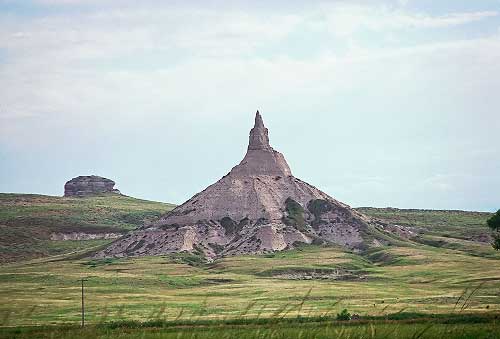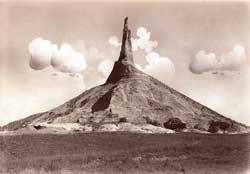Chimney Rock National Historic Site

"At this place was a singular phenomenon, which is among the curiosities of the country. It is called Chimney. The lower part is a conical mound rising out of the naked plain; from the summit shoots up a shaft or column, about one hundred and twenty feet in height, from which it derives its name. The height of the whole . . . is a hundred and seventy five yards . . . and may be seen at the distance of upwards of thirty miles."Capt. Benjamin Bonneville, 1832

|
| Old photo of Chimney Rock. |
| Pioneer Accounts |
|---|
|
Rufus Sage (October 26, 1841)
"Raising camp at daylight, we resumed our way and soon afterwards arrived opposite the 'Chimney,' an extraordinary curiosity that had continued in view and excited our admiration for some four days past. "This singular formation surmounts a conical eminence which rises, isolated and lonely, in the open prairie, reaching a height of 300 feet... A grand, an imposing spectacle, true--a wonderful display of the eccentricity of Nature!"
|
|
Jesse A. Applegate, age 7 in 1843
"Chimney Rock... was near the line of march, and we could see it, it seemed to me, for several days before we passed near it. At first we could only see a pinnacle afar off, looking much like a chimney flue or church steeple...Nearer, we could see that the chimney-like pinnacles were on top of a mountain or high hill... It seemed to me to touch the sky. "We went into camp not far from it, as we supposed. Some of the young men that evening visited the rock and returned quite late at night. They declared it was ten miles away." |
|
Peter Decker (May 29, 1849) "I asscended [Chimney Rock] about 150 feet by a winding step path. Many names cut in sand rock. Inscribed mine. Fired one of my holster pistols and echoed greatly."
|
|
Joseph Hackney (June 9, 1849)
"We passed chimney Rock at ten o'clock. This is the most remarkable object that I ever saw, and if situated in the states, would be visited by persons from all parts of the world...It can be seen for 20 miles before you get to it." |
Chimney Rock early became a guide for "mountain men"--Rocky Mountain trappers and traders--on their seasonal travels between the Rockies and the Missouri River trading posts. The first white men to see the column were probably Robert Stuart and his small group of traders on their way back from Astoria in the Oregon Country in 1813. Fourteen years later, 1827, the first recorded use of the name occurred in Joshua Pilcher's report on his journey up the Platte Valley to the Salt Lake rendezvous of the fur trappers.
Among chroniclers of the landmark are names famous in the annals of American expansion into the West; Captain Bonneville in 1832, William Anderson and William Sublette in 1834, the Congregational missionary Samuel Parker in 1835, the artist Alfred J. Miller in 1837, Father De Smet in 1840 and again in 1841. Charles Preuss of Fremont's expedition in a842, members of Gen. Stephen Kearny's dragoons in 1845, the historian Francis Parkman in 1846, and the pioneer artist and photographer William Henry Jackson in 1866.
But it is in the journals of hundreds of covered wagon emigrants that Chimney Rock's importance to the pioneers can best be gauged. From far out on the plains, wagon train outriders could see the spire. To them it signaled that the second phase of their long journey west--the difficult mountain passage--was about to begin. More immediately, the rock offered respite to weary emigrants heading for homes in Oregon, gold fields in California, or Mormon havens in Utah. The spectacular shaft marked a good camping spot with a dependable spring.
So intrigued were the emigrants that thousands clambered up the cone to carve their names on the tower. Many passersby on the north side of the river waded over just to climb "this great natural curiosity." Though no inscriptions are know to survive today, there is ample testimony that thousands of names once adorned the rock.